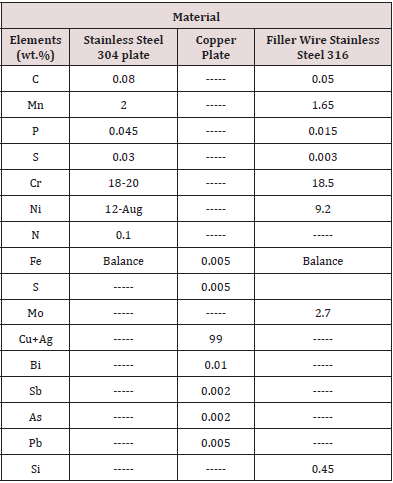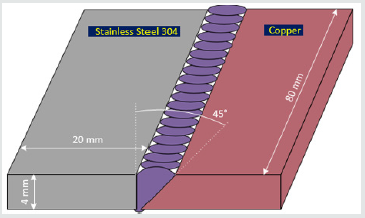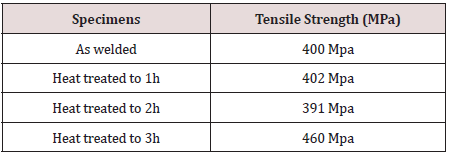
Lupine Publishers Group
Lupine Publishers
Menu
ISSN: 2641-6921
Short Communication(ISSN: 2641-6921) 
Mechanical Properties Study of Copper/Stainless Steel Dissimilar Weld Joints Volume 2 - Issue 4
Yogesh Singla1* and Rakesh Joshi2
- 1Materials Science and Engineering Department, Case Western Reserve University, USA
- 2Research Scientist, Design and Product Development Department, India
Received: February 23, 2020; Published: March 10, 2020
*Corresponding author: Yogesh Singla, Research Associate, Materials Science and Engineering Department, Case Western Reserve University, USA
DOI: 10.32474/MAMS.2020.02.000144
Abstract
The objective of the present investigation was to measure the mechanical properties of dissimilar weld joints of copper to stainless steel 304, fabricated using Tungsten inert gas (TIG) welding process. As-welded specimens were heat treated to a temperature of 650 °C for 1h, 2h and 3h. Tensile strength and microhardness measurements were made to analyze the effect of post weld heat treatment on the mechanical properties of dissimilar weld joints of copper and stainless steel. Specimens heat treated at 3h showed increase tensile strength and hardness, when compared to the specimen’s heat treated at 1h and 2h.
Keywords: TIG welding; Heat treatment; Hardness; Tensile strength; Mechanical properties
Abbreviations: GMAW: Gas Metal Arc Welding; GTAW: Gas Tungsten Arc Welding; SAW: Submerged Arc Welding; TIG: Tungsten Inert Gas
Introduction
In the rapid development and improvement of welding
techniques, rivets and fasteners have now been replaced with
welding for joining of machine component. Welding has many
advantages over other joining processes; however, it also has
harmful metallurgical effects on the welded region of the joint.
Most of the structural joins are developed using stainless steel.
This is because of its good weldability property. Copper has also
been recognized as a suitable candidate to due to the combined
properties, such as strength, conductivity, corrosion resistance
and ductility. Copper and its alloy have high thermal conductivity
in comparison to stainless steel. Therefore, the use of this material
is helpful to reduce the heat dissipation to the environment. The
reduced heat dissipation can significantly decrease the formation
probability of deleterious phases, such as sigma phase after prolong
heating [1-8]. Many researchers have published the effect of various
joining processes on the weld properties of copper to stainless steel
joints. Mai et al. [1] and Yao et al. [4] used laser welding process
for joining of copper to stainless steel. Magnabosco et al. [2] have
studied the properties of copper/stainless steel using electron
beam welding. Similarly, Durgutlu et al. [5] and Akbari et al. [7-
8] have talked about the influence of joining of copper/stainless
steel by explosive welding on the mechanical and microstructural
properties.
Conventional welding processes, such as gas metal arc welding
(GMAW), gas tungsten arc welding (GTAW) and submerged
arc welding (SAW) are mostly used for joining, since, higher
operational costs limits the use of laser and electron beam welding
[3]. In the present study, bimetallic joint formed between copper
and stainless steel 304 with the help of tungsten inert gas (TIG)
welding. Mechanical properties of the weld joints were measured
via tensile strength and microhardness evaluation of the interfacial
region between copper and stainless steel 304.
Experimental Details
Two plates, stainless steel 304 and copper having dimensions 80×20×4 mm3 were used as a substrate material. The nominal chemical composition is given in Table 1. Both the plates were welded together with Tungsten Inert Gas (TIG) welding with a filler wire made of stainless steel 316. It is well known that due to the higher thermal conductivity of copper, heat losses are more, therefore, to minimize the effect of heat losses, single bevel joint was made on copper side at an angle of 45°. Schematic of welding of the two plates is shown in (Figure 1). Prior to welding, both the plates were cleaned with acetone. TIG welding parameters throughout experimentation are presented in Table 2. Post weld heat treatment process was carried out in a muffle furnace at a temperature of 650 °C. A total of three samples were prepared from the weld zones, each of which was heated for 1,2 and 3hrs. After heat treating at a set temperature and time, the samples were allowed to cool at room temperature. The tensile strength of both as welded and heattreated samples having dimensions 140×10×4 mm3 was evaluated at a room temperature using universal tensile testing machine. In order to perform the hardness tests of as welded and heat-treated samples, three regions, namely, base of stainless steel, welded region and base of copper was selected. Microhardness tests were done at constant load of 200g with 20s of dwell time and an average of 5 readings has been reported
Results and Discussion
After welding, tensile strength of as-welded specimen and heattreated specimens was taken and is listed in Table 3. It is seen that the tensile strength of as welded specimen is 400Mpa. Heat treatment of specimens after heat treated to 1h and 2h has no effect on the tensile strength of the specimens, when compared to the tensile strength of the as-welded specimen. The tensile strength of the specimen heat treated to 3h has increased from 400Mpa to 460Mpa in comparison to the tensile strength of the as-welded specimen. This increase in the tensile strength formation of diffusion layer at the interfacial region of steel and copper, which generally forms after post weld heat treatments. The results of tensile strength are in good agreement with the finding of Bina et al. [9], who have studied the influence of heat treatment on the bonding interface of copper and stainless-steel joint welded through explosive welding. The Results of the present study exhibited that the heat treating of specimens up to 2h is not sufficient to build the diffusion layer at the interfacial region, necessary to increase the tensile strength of the welded joints. Diffusion layer functions as a barrier against dislocations, gives rise to enhanced tensile strength. It is also well known that the formation of grains close to the diffusion layer is fine, which is helpful to restrict grain growth during recrystallization, hence increased tensile strength is obtained.
Microhardness measurements made on stainless steel, copper fusion zone of as welded and fusion zone of heat-treated specimens at 1h, 2h and 3h are tabulated in Table 4. From Table 4, it can be observed that hardness of as-welded fusion zone is equivalent to the hardness of the fusion zone of heat-treated specimens. After 3h of post weld heat treatment, hardness was found to increase up to 176.4VHN. The increase of hardness in the fusion zone of heattreated specimen may be because of the formation of a fine-grained diffusion layer at the interfacial region of stainless steel and copper joint. The results of hardness variation are in consistent with the findings of Bina et al. [9].
Conclusion
Copper to stainless steel joints were successfully developed using TIG welding. The study reveals that heat treat of dissimilar weld joints of copper and stainless steel can significantly enhance the mechanical properties of dissimilar weld joints. The tensile strength was increased after post weld heat treatments.
Acknowledgement
The authors would like to thank “the DARVUN, INDIA for providing financial support to carry out this research work.
References
- Mai TA, Spowage AC (2004) Characterization of dissimilar joints in laser welding of steel-kovar, copper-steel and copper aluminum. Materials science and Engineering A 374: 224-233.
- Magnabosco I, Ferro P, Bonollo F, Arnberg I (2006) An investigation of fusion zone microstructures in electron beam welding of copper-stainless steel. Materials science and engineering A 424(1-2): 163-173.
- Shiri SG, Nazarzadeh M, Sharifitabar M, Afarani MS (2012)Gas tungsten arc welding of CP-Copper to 304 Stainless steel using different filler material. Transactions of Nonferrous Metals Society of China 22(12): 2937-2942.
- Yao C,Xu B, Xhang X, Uang J, Fu J, et al. (2009)Interface microstructure and mechanical properties of laser welding copper-steel dissimilar joint. Optics and Lasers in Engineering 47(7-8): 807-814.
- Durgutlu A, Gulence B, Findik F (2005)Examination of copper/stainless steel joints formed by explosive welding. Materials and Design 26(6): 497-507.
- Imani Y, Givi MK, Guillot M (2011)Improving friction stir welding between copper and 304L stainless steel. Advance Materials Research 409: 263-268.
- AkbariMousav SAA, Barrett LM, AlHassani STS (2008)Explosive welding of metal plates. Materials Processing Technology 202(1-3): 224-239.
- AkbariMousavi SAA, Sartangi PF (2009)Explosive welding of cp-titanium/AISI 304 stainless steel. Materials and Design 30(3): 459-468.
- Bina MH, Dehghani F, Salimi M (2013)Effect of heat treatment on bonding interface in explosive welded copper/stainless steel. Materials and Design 45: 504-509.

Top Editors
-

Mark E Smith
Bio chemistry
University of Texas Medical Branch, USA -

Lawrence A Presley
Department of Criminal Justice
Liberty University, USA -

Thomas W Miller
Department of Psychiatry
University of Kentucky, USA -

Gjumrakch Aliev
Department of Medicine
Gally International Biomedical Research & Consulting LLC, USA -

Christopher Bryant
Department of Urbanisation and Agricultural
Montreal university, USA -

Robert William Frare
Oral & Maxillofacial Pathology
New York University, USA -

Rudolph Modesto Navari
Gastroenterology and Hepatology
University of Alabama, UK -

Andrew Hague
Department of Medicine
Universities of Bradford, UK -

George Gregory Buttigieg
Maltese College of Obstetrics and Gynaecology, Europe -

Chen-Hsiung Yeh
Oncology
Circulogene Theranostics, England -
.png)
Emilio Bucio-Carrillo
Radiation Chemistry
National University of Mexico, USA -
.jpg)
Casey J Grenier
Analytical Chemistry
Wentworth Institute of Technology, USA -
Hany Atalah
Minimally Invasive Surgery
Mercer University school of Medicine, USA -

Abu-Hussein Muhamad
Pediatric Dentistry
University of Athens , Greece

The annual scholar awards from Lupine Publishers honor a selected number Read More...









